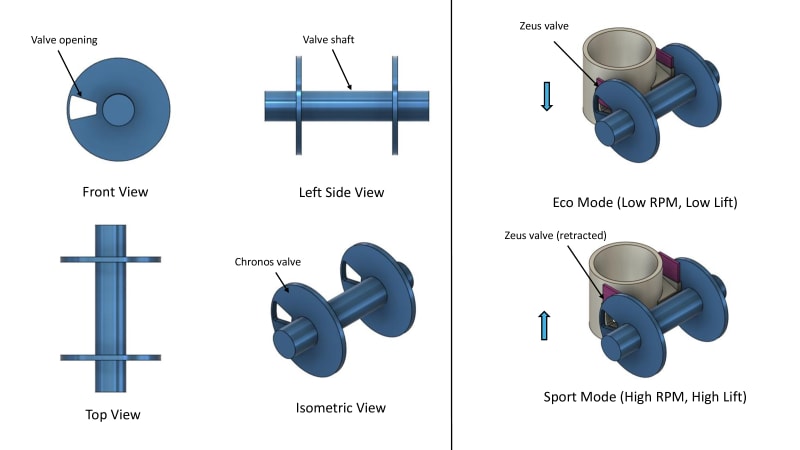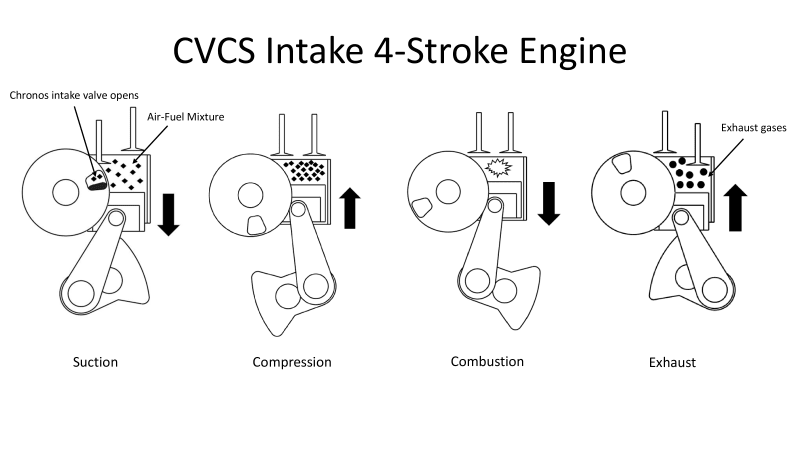The major breakthroughs in internal combustion engine technology have been around optimizing the breathing capacity of an engine. However, the breathability has reached a saturation point, resulting in no recently significant improvements in engine performance. This plateau is largely due to the size of the intake and exhaust valves being constrained by the bore of the cylinder.
The Chronos Valve Control System breaks this barrier by precisely timing the opening/closing of ports located along the lateral surface (sides) of the cylinder. The CVCS consists of a disc-shaped valve with openings (Chronos valve) mounted on a rotating valve shaft driven by the crankshaft via belt, chain, or gear.
Additionally, the ECU controlled Zeus valve (sliding flap valve) can alter the timing and amount of intake/exhaust gases entering the cylinder by changing the shape of the port opening. This enables Variable Valve Timing and Lift. While systems like VTEC or Camtronic require complex, heavy cam profiles, the CVCS offers a much simpler solution.
In 4-stroke engines, CVCS acts as the auxiliary valve system alongside overhead valves. The CVCS intake valve (or exhaust valve) is open for a duration of 120 degrees of crankshaft rotation (opens ~ 60 degrees after the overhead valves open). CVCS increases valve surface area by ~30%, resulting in a power increase of approximately 10–15%, Power_CVCS = Power* (1 + k(Area_CVCS/Area_Total)), k ~ 0.5.
CVCS also serves as the exhaust valve in pressure-lubricated, Euro 6-compliant 2-stroke engines. Its superior volumetric efficiency makes it a better alternative to overhead valves used in turbocharged 2-strokes. Compared to Euro 5-compliant TPI engines, a CVCS 2-stroke with pressure lubrication can reduce hydrocarbon emissions by ~40% (from ~8 g/kWh to under 5 g/kWh).
Additionally, a CVCS-equipped 6-stroke engine (two times three strokes) combines 2-stroke power with 4-stroke efficiency, producing two combustion events per six strokes. A 6-stroke delivers ~25% more power than a conventional 4-stroke of the same displacement.
CVCS components are cast and CNC machined from alloyed steel. With few moving parts and a compact side-mounted design, it’s easier and less expensive to manufacture compared to existing cam-poppet valve systems. The CVCS uses 100% existing, conventional technology. Additional FEA testing reveals that the Chronos valve disc remains within safe stress limits at 12000 RPM, making it feasible for operating under high loads.
The CVCS has fewer moving parts and can operate at a higher RPM than sleeve valves. The CVCS is lighter and more compact than rotary valves, making them more practical in modern-day automobiles than existing alternative valve systems.
Internal combustion engines play a key role in achieving a sustainable future. CVCS-equipped 2-, 4-, and 6-stroke engines are ideal for hybrid electric vehicles and hydrogen ICEs due to their lower emissions, improved efficiency, and greater power density.
Hydrogen combustion engines are currently impractical for mass production due to the lower energy density of hydrogen compared to fossil fuels. The gains in breathing efficiency and power offered by CVCS can make them feasible and unlock a new untapped market for hydrogen combustion engines.
Video
Like this entry?
-
About the Entrant
- Name:Ramachandran Nagarajan
- Type of entry:individual
- Software used for this entry:Fusion 360, Catia V6
- Patent status:pending








